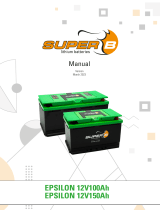
7
Be in charge. Super B.
2. Introduction
2.1. Product description
The Andrena power batteries are light-weighted, compact and offer high performances. The
Li-ion batteries are especially developed for motorsports. If you want to use it on road, please
consult with Super B.
Please note that Li-ion batteries have to be treated differently from conventional lead-acid
batteries. We kindly ask you to pay attention to the warnings as mentioned on the battery:
1.Risk of re and burns when not used or treated correctly.
2.Do not open, crush, heat above 60°C or incinerate.
3.Follow manufacturer’s instructions.
4.Avoid contact with electrolyte. In the event of an accident, ush with water.
5.Do not jumpstart.
6.Use correct charger.
7.Do not puncture or impact this battery.
8.Do not short battery terminals.
9.Do not reverse connect (polarity).
10.Do not operate battery beyond published maximum specications.
11.This product can store fault conditions internally, like excessive charge current or deep
discharge situations. Super B uses this information in the warranty process.
2.2. Intented use
The Andrena series Li-ion battery serves as a voltage source for starting combustion engines,
which use a 12V board net. Also stationary applications which require a short and high peak
current can benet from using this Li-ion battery. In applications other than motorcycles it is
required to use the Relay BDB 12V/24V 250A; an external under and overvoltage protector, to
secure the Andrena Li-ion battery against under- and overvoltage with the lowest possible
stand-by current. Never install multiple Li-ion batteries in series or parallel.
2.3. Glossary of Terminology
Endurance Life-cycle: The products maximum lifespan, achieved by following the guidelines
presented in this manual
Charge cycle: A period of use from fully charged, to fully discharged, and fully
recharged again
CCCV: Constant Current - Constant Voltage
LiFeP04 Lithium Iron Phosphate
Table 1. Glossary of terminology






















